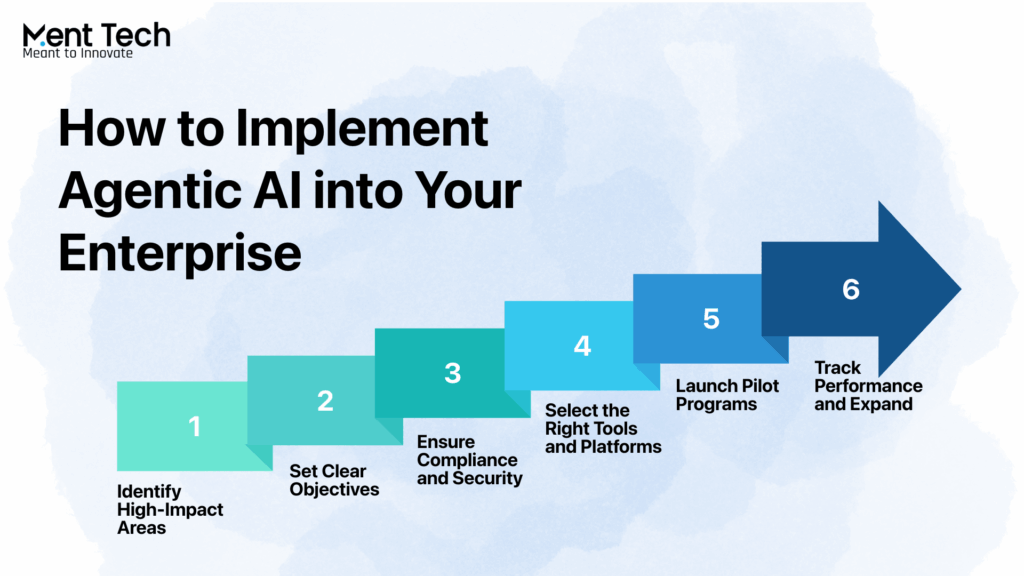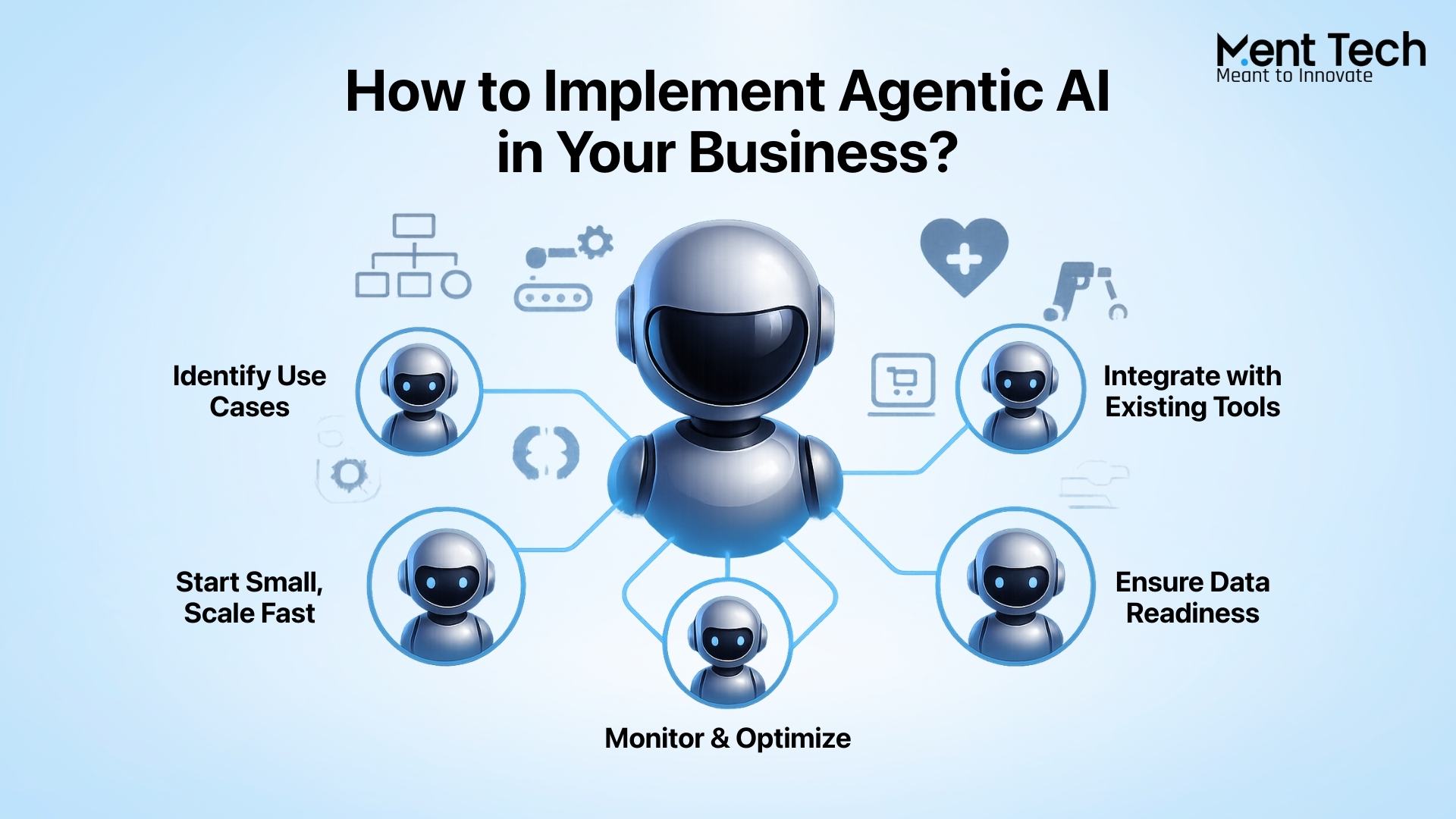Finding it hard to keep pace with rising customer demands, delayed decisions, or repetitive tasks that drain your team’s energy? Many businesses face the same challenges, and despite heavy investments in AI, the results often fall short. While 78% of companies use AI regularly, only 1% call their strategies truly mature. The problem isn’t the technology, it’s how it’s being applied.
Agentic AI changes this. Unlike traditional tools that wait for prompts, agentic systems anticipate challenges, make decisions, and act autonomously. They integrate with your existing systems, adapt in real time, and handle end-to-end processes without constant oversight.
This shift turns AI from a reactive assistant into a proactive business partner. If you’re wondering where to start, which use cases to prioritize, and how to scale smoothly, this guide will guide you step by step.
Market Reality Check: McKinsey research shows that while horizontal AI implementations (like enterprise copilots) have scaled quickly, over 90% of vertical AI use cases remain stuck in pilot mode. The companies breaking through this barrier are those implementing true agentic AI systems that can handle end-to-end business processes.

What is Agentic AI?
Agentic AI refers to autonomous systems capable of operating in physical, digital, or hybrid environments. They perceive data from their surroundings, analyze it, make decisions, and act to achieve goals ranging from robots and drones to software performing complex digital tasks.
Unlike traditional rule-based programs, agentic AI adapts to changing conditions and objectives. Leveraging technologies like Large Language Models (LLMs), these systems learn from interactions, continuously improving performance and efficiency over time.
Examples of Common Tasks AI Agents Can Handle in Business:
AI agentic systems can efficiently manage a wide array of business activities. In customer support, they power chatbots that deliver quick, accurate responses, improving service quality and customer satisfaction.
For marketing, agentic AI analyzes extensive data to personalize campaigns and target the right audience, boosting engagement and results. They also enhance supply chain operations by predicting demand, optimizing inventory, and ensuring smoother logistics.
What is a Multi-Agentic System (MAS)?
A Multi-Agentic System (MAS) is a network of intelligent, autonomous agentic entities that interact and collaborate to solve complex problems. Each agentic unit can perceive its environment, make decisions, and take actions, enabling the system to operate efficiently and adaptively across dynamic situations. MAS is widely used in industries for automation, optimization, and real-time decision-making.
Key Benefits of a Multi-Agentic System
- Adaptability and Scalability: Easily add or modify agentic units to handle evolving tasks and large-scale operations.
- Resilience and Reliability: Decentralized control ensures the system keeps running even if some agentic units fail.
- Autonomy and Collaboration: Agentic units coordinate and self-organize to efficiently divide tasks and resolve conflicts.
- Rapid Responsiveness: Immediate reaction to real-time events improves outcomes in areas like traffic management and disaster response.
Benefits of using Agentic AI for Enterprises

Adopting agentic AI empowers businesses with autonomous systems that learn and adapt. Enterprise AI Integration helps these agents boost efficiency, drive innovation, and improve operational performance.
• Enhanced Efficiency
AI agents handle repetitive tasks like data entry, scheduling, and basic analysis, freeing human resources for strategic and creative work. This boosts overall productivity and allows teams to focus on high-value initiatives.
• Personalized Customer Experiences
By analyzing user data and past interactions, AI agents deliver tailored recommendations and services. This personalization increases satisfaction, loyalty, and repeat business by making customers feel understood, helping businesses improve both customer experience and essential processes like business registration.
• 24/7 Availability
AI agents operate continuously without breaks or fatigue, ensuring round-the-clock service, support, and monitoring. Businesses can respond promptly to customer queries and market demands at any time.
• Data-Driven Insights
AI agents gather and analyze large volumes of data in real time, uncovering trends in customer behavior, market shifts, and operational performance. These insights enable faster, informed decisions and optimized strategies.
• Cost Optimization
Deploying AI agents reduces the need for large teams handling routine tasks, cutting salary, training, and operational expenses. Process efficiencies translate into long-term savings and better resource allocation.
• Scalability and Adaptability
AI agents scale to manage increasing workloads without extra human labor. Their ability to learn and adjust to new challenges ensures enterprises can grow efficiently while maintaining service quality.
How Do You Actually Implement Agentic AI in Your Business?

Integrating agentic AI into business operations can seem complex, but a structured approach ensures smooth adoption and measurable impact.
1. Identify High-Impact Areas
Analyze your processes to find repetitive tasks, bottlenecks, or slow decision-making. Focus on areas like customer support, lead management, or workflow automation where AI can deliver immediate value.
2. Set Clear Objectives
Define measurable goals for AI deployment, such as faster responses, improved insights, or streamlined operations. Clear objectives help track performance and demonstrate ROI.
3. Ensure Compliance and Security
Verify that AI implementation, including AI for KYC, aligns with industry regulations and internal security policies. Prioritizing compliance reduces risk, protects data, and builds stakeholder confidence.
4. Select the Right Tools and Platforms
Choose AI technologies built for autonomous reasoning and multi-step decision-making. Ensure compatibility with your existing IT infrastructure and scalability for future growth.
5. Launch Pilot Programs
Start small with a pilot program to identify gaps, refine workflows, and measure impact without disrupting critical operations. Collect feedback for continuous improvement.
6. Track Performance and Expand
Monitor key metrics such as efficiency, accuracy, and user satisfaction. Use insights to optimize AI workflows and gradually scale agentic AI across departments for maximum business value.
ROI Reality: Companies typically see 20-66% productivity improvements within six months of implementation. A retail bank recently achieved 30% faster credit processing and a 50% reduction in manual review time, resulting in $2.3M in annual savings against a $180,000 implementation cost.
Top Use Cases of AI Agentic in Enterprise Operations
AI agentic systems are transforming enterprise operations by automating processes, providing actionable insights, and enabling smarter decision-making. Here are 5 key ways they’re being applied across businesses:
1. Workflow Automation
AI agentic systems streamline project workflows by gathering data, managing milestones, and coordinating communication between departments. They reduce manual effort, predict bottlenecks, and ensure tasks progress efficiently.
2. Smart Task Management
AI agentic systems handle repetitive tasks such as data entry, email filtering, and document organization. This improves accuracy, saves time, and allows teams to focus on strategic, high-value initiatives.
3. Content & Social Media Optimization
AI agentic systems assist in creating, curating, and optimizing content across blogs, social media, and campaigns. They analyze trends, maintain brand voice, and help businesses engage their audience effectively. When optimizing written content, an AI humanizer can refine the tone, improve readability, and ensure text sounds natural while staying true to the brand’s voice
4. Research & Data Analysis
AI agentic systems accelerate market research, competitive analysis, and data-driven insights. They summarize reports, identify patterns, and support faster, smarter strategic decisions.
5. Customer Engagement & Lead Management
AI agentic systems enhance customer interactions through personalized responses, query resolution, and lead nurturing. They capture, qualify, and manage leads efficiently, boosting engagement and conversion rates.
Key Challenges and Considerations in Deploying Agentic AI for Enterprises
| Area of Concern | Challenge | Recommended Approaches |
| System Integration | Connecting AI agents with existing platforms can create compatibility issues and disrupt workflows. | Start with pilot projects, integrate gradually, and ensure cross-functional collaboration. Provide staff training for smoother adoption. |
Data Privacy & Security | Handling sensitive data while staying compliant with evolving regulations is a major concern. | Run regular risk assessments, strengthen security layers, limit third-party data sharing, and use robust data protection policies. |
| Continuous Training & Maintenance | AI agents require ongoing updates and retraining to stay effective, which can strain resources. | Establish a structured update cycle, allocate dedicated support, and ensure quick issue resolution. |
| Balancing Automation & Oversight | Excessive automation risks errors, while too little limits efficiency gains. | Build in human checkpoints for critical tasks and maintain oversight protocols in high-risk areas. |
| Scalability | Expanding AI systems to meet business growth requires flexible infrastructure. | Plan scalability and leverage cloud elasticity and containerization for adaptive resource management. |
| Ethical & Responsible Use | Bias, unfairness, and a lack of transparency can undermine trust in AI agents. | Implement explainability measures, audit algorithms regularly, and enforce fairness standards. |
AI Agentic Applications in Business Operations
AI agentic systems are transforming enterprise operations by automating workflows, improving decision-making, and driving innovation. Across industries, they enable businesses to operate more efficiently, respond faster to challenges, and deliver better outcomes.
1. Finance: AI agentic systems streamline risk assessment, detect fraudulent activity, and automate tasks like financial reporting, KYC verification, and personalized financial services, helping institutions make faster and more accurate decisions.
2. Healthcare: From personalized treatment recommendations to automated diagnostics, AI solutions in patient monitoring and clinical decision support enable AI agentic systems to enhance patient care, improve operational efficiency, and accelerate medical research.
3. Supply Chain & Logistics: AI agentic systems optimize inventory, forecast demand, manage transportation routes, and automate warehouse operations, reducing costs, improving delivery times, and enhancing overall supply chain efficiency.
4. Manufacturing: AI agentic systems monitor production, predict equipment maintenance, ensure quality control, and drive process optimization, enabling higher efficiency, reduced downtime, and smarter factory operations.
5. Marketing & Customer Experience: AI agentic systems analyze customer data to personalize campaigns, automate support through chatbots, and optimize customer journeys, boosting engagement, satisfaction, and conversion rates.

Conclusion
Agentic AI Frameworks are more than new tools. They transform how enterprises run operations, automating workflows, improving quality, and accelerating R&D to enable new business models. Early adopters gain first-mover advantages, while those who wait risk missing efficiency and revenue opportunities.
MentTech, a leading AI agent development company, recommends starting with small experiments with key use cases and integrating agentic AI into business processes that truly need enhancement. The key is aligning your AI strategy with business goals and preparing teams to adapt. With the right approach, AI agents can become your most efficient digital partners.
Integrate agentic AI into your business to enhance efficiency, support smarter decisions, and achieve measurable results. Contact us today to discuss further!
FAQs:
Regular AI responds to prompts and performs specific tasks when asked. Agentic AI proactively identifies problems, creates plans, executes actions across multiple systems, and adapts based on results all with minimal human intervention.
Initial pilot implementations typically take 8-12 weeks, with full-scale deployment occurring over 3-6 months. Timeline varies based on system complexity, integration requirements, and organizational readiness.
Most organizations see 20-60% productivity improvements and 20-40% cost reductions within the first year. However, ROI varies significantly based on use case, implementation quality, and organizational factors.
Modern agentic AI systems can be built on cloud infrastructure using APIs and existing business systems. You don’t need specialized hardware, but you do need proper integration architecture and data access.
Successful implementations include robust governance frameworks, audit trails, human oversight mechanisms, and compliance controls. Agents operate within defined parameters and escalate decisions that require human judgment.
Agentic AI is accessible to businesses of all sizes. Small businesses often see faster implementation and clearer ROI due to simpler system landscapes and more focused use cases. Many solutions can be implemented for under $100,000.



